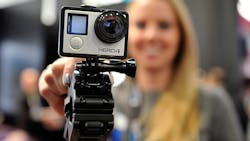GoPro Misses Sales Estimates on Lagging Demand, Drone Delay
GoPro Inc. gave a disappointing outlook for sales this quarter, missing analysts’ estimates and reflecting slow demand for its action cameras and the delayed launch of a new drone. The shares fell as much as 14%.
Revenue will be $190 million to $210 million in the first quarter, GoPro said in a statement Thursday after the markets closed. Analysts were expecting $267.6 million, on average. In the fourth quarter, sales rose 24% to $540.6 million, also missing analysts’ average estimate for $573.3 million.
The past several months have been especially hard on GoPro. The company was forced to recall its Karma drone in November, less than two months after its much-hyped debut, due to problems with the battery that led some of them to lose power in mid-flight. CEO Nick Woodman had been betting on Karma and the new Hero5 cameras to revitalize demand and the company’s flagging share price. But Karma’s stumble only added to a string of mishaps, including production delays for the drone and the Hero5 that led the company in November to reduce its sales targets for 2016.
The drone is back on sale as of earlier this week with limited initial shipments, but it faces intense competition from more experienced manufacturers like China’s SZ DJI Technology Co.
“Bulls were hoping that the Hero5 refresh would be material enough to return GoPro to growth. This raises additional questions,” said Joe Wittine, an analyst at Longbow Research. “They also guided low in gross margin, but they will cut a lot more costs. It seems like they’re acknowledging that growth isn’t what they hoped for.”
The company forecast first-quarter gross margins will be in the low-30% range, compared with the average analyst estimate of 40.5%. The shares tumbled to $9.45 in post-market trading having gained 3.8% Thursday to close at $10.97. After peaking at a high of $93.85 in October 2014, the stock has been lurking below its IPO price of $24 since late 2015.
In the fourth quarter, GoPro reported earnings excluding some costs of $42.4 million, after a loss of $11.4 million a year earlier. Adjusted earnings per share were 29 cents, higher than analysts’ average estimate of 22 cents. Charges in the quarter included $102 million for a full valuation allowance on deferred tax assets and about $37 million for restructuring.
San Mateo, California-based GoPro is transitioning to focus on more realistic visions. It’s pared back an ambitious strategy of building a media company around its action-packed GoPro videos online. The company said in November that it would eliminate about 15% of its workforce and shut down its entertainment division to reduce costs. GoPro said Thursday that it would reduce its adjusted operating expenses to less than $600 million this year. There have also been some management shake-ups, including the departure of Tony Bates, who joined GoPro as President in 2014.
For now, the company is working on making the process of using a GoPro camera from capture to sharing as easy as possible. It’s tried to diversify its revenue stream by offering a cloud-based subscription service that allows users to store, edit and share content. Yet some analysts are doubtful that meaningful revenue will come from GoPro’s software offerings in the near future.
By Selina Wang
About the Author
Bloomberg
Licensed content from Bloomberg, copyright 2016.
